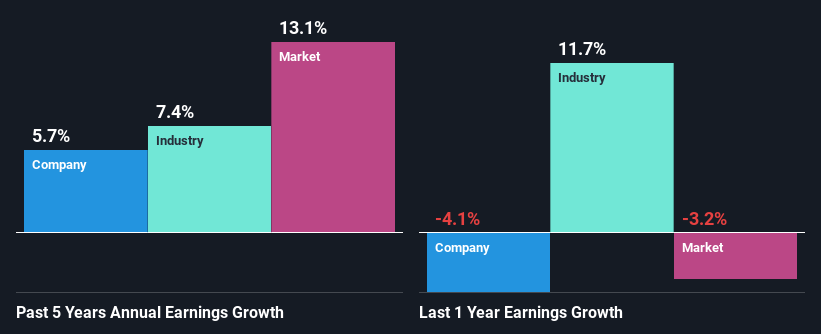Are Robust Financials Driving The Recent Rally In ESAB Corporation's (NYSE:ESAB) Stock?
Most readers would already be aware that ESAB's (NYSE:ESAB) stock increased significantly by 24% over the past three months. Given the company's impressive performance, we decided to study its financial indicators more closely as a company's financial health over the long-term usually dictates market outcomes. Particularly, we will be paying attention to ESAB's ROE today.
Return on equity or ROE is a key measure used to assess how efficiently a company's management is utilizing the company's capital. Put another way, it reveals the company's success at turning shareholder investments into profits.
See our latest analysis for ESAB
How Do You Calculate Return On Equity?
ROE can be calculated by using the formula:
Return on Equity = Net Profit (from continuing operations) ÷ Shareholders' Equity
So, based on the above formula, the ROE for ESAB is:
14% = US$223m ÷ US$1.6b (Based on the trailing twelve months to December 2023).
The 'return' is the profit over the last twelve months. That means that for every $1 worth of shareholders' equity, the company generated $0.14 in profit.
What Has ROE Got To Do With Earnings Growth?
We have already established that ROE serves as an efficient profit-generating gauge for a company's future earnings. We now need to evaluate how much profit the company reinvests or "retains" for future growth which then gives us an idea about the growth potential of the company. Generally speaking, other things being equal, firms with a high return on equity and profit retention, have a higher growth rate than firms that don’t share these attributes.
A Side By Side comparison of ESAB's Earnings Growth And 14% ROE
At first glance, ESAB seems to have a decent ROE. Even when compared to the industry average of 14% the company's ROE looks quite decent. This probably goes some way in explaining ESAB's moderate 5.7% growth over the past five years amongst other factors.
As a next step, we compared ESAB's net income growth with the industry and were disappointed to see that the company's growth is lower than the industry average growth of 7.4% in the same period.
The basis for attaching value to a company is, to a great extent, tied to its earnings growth. The investor should try to establish if the expected growth or decline in earnings, whichever the case may be, is priced in. Doing so will help them establish if the stock's future looks promising or ominous. Has the market priced in the future outlook for ESAB? You can find out in our latest intrinsic value infographic research report.
Is ESAB Efficiently Re-investing Its Profits?
In ESAB's case, its respectable earnings growth can probably be explained by its low three-year median payout ratio of 4.7% (or a retention ratio of 95%), which suggests that the company is investing most of its profits to grow its business.
While ESAB has been growing its earnings, it only recently started to pay dividends which likely means that the company decided to impress new and existing shareholders with a dividend. Based on the latest analysts' estimates, we found that the company's future payout ratio over the next three years is expected to hold steady at 5.3%. Therefore, the company's future ROE is also not expected to change by much with analysts predicting an ROE of 14%.
Summary
On the whole, we feel that ESAB's performance has been quite good. Specifically, we like that the company is reinvesting a huge chunk of its profits at a high rate of return. This of course has caused the company to see a good amount of growth in its earnings. That being so, the latest analyst forecasts show that the company will continue to see an expansion in its earnings. To know more about the latest analysts predictions for the company, check out this visualization of analyst forecasts for the company.
Have feedback on this article? Concerned about the content? Get in touch with us directly. Alternatively, email editorial-team (at) simplywallst.com.
This article by Simply Wall St is general in nature. We provide commentary based on historical data and analyst forecasts only using an unbiased methodology and our articles are not intended to be financial advice. It does not constitute a recommendation to buy or sell any stock, and does not take account of your objectives, or your financial situation. We aim to bring you long-term focused analysis driven by fundamental data. Note that our analysis may not factor in the latest price-sensitive company announcements or qualitative material. Simply Wall St has no position in any stocks mentioned.

